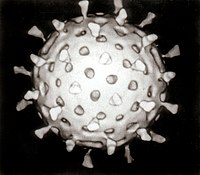
Photo from wikipedia
Enterocyte invasion by the gastrointestinal pathogen Salmonella enterica is accompanied by loss of brush border and massive remodeling of the actin cytoskeleton, leading to microvilli effacement and formation of membrane… Click to show full abstract
Enterocyte invasion by the gastrointestinal pathogen Salmonella enterica is accompanied by loss of brush border and massive remodeling of the actin cytoskeleton, leading to microvilli effacement and formation of membrane ruffles. These manipulations are mediated by effector proteins translocated by the Salmonella Pathogenicity Island 1-encoded type III secretion system (SPI1-T3SS). To unravel the mechanisms of microvilli effacement and contribution of SPI1-T3SS effector proteins, the dynamics of host-pathogen interactions was analyzed using live cell imaging (LCI) of polarized epithelial cells (PEC) expressing LifeAct-GFP. PEC were infected with S. enterica wild-type and mutant strains with defined defects in SPI1-T3SS effector proteins, and pharmacological inhibition of actin assembly were applied. We identified that microvilli effacement involves two distinct mechanisms: i) F-actin depolymerization mediated by villin and ii), the consumption of cytoplasmic G-actin by formation of membrane ruffles. By analyzing the contribution of individual SPI1-T3SS effector proteins, we demonstrate that SopE dominantly triggers microvilli effacement and formation of membrane ruffles. Furthermore, SopE via Rac1 indirectly manipulates villin, which culminates in F-actin depolymerization. Collectively, these results indicate that SopE has dual functions during F-actin remodeling in PEC. While SopE-Rac1 triggers F-actin polymerization and ruffle formation, activation of PLCγ and villin by SopE depolymerizes F-actin in PEC. These results demonstrate the key role of SopE in destruction of the intestinal barrier during intestinal infection by Salmonella.
Journal Title: Frontiers in Cellular and Infection Microbiology
Year Published: 2023
Link to full text (if available)
Share on Social Media: Sign Up to like & get
recommendations!